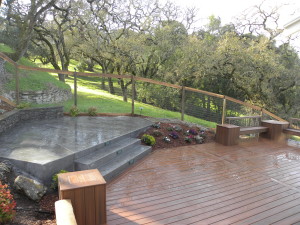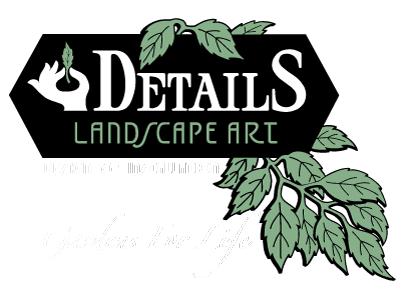The design and installation of residential landscaping in Sonoma County has been the hallmark of Details Landscape Art since 1991. Our gardens have evolved and changed over time as we experienced the maturation and growth of various elements of our designs, both positive and negative. One of the significant changes has been our construction of decks.

Often homeowners requiring a hardscape surface have a choice of decking or a concrete or stone or brick patio. Where the grade of the property is relatively flat, any of the above surfaces are possible. Where there is a steep hillside, however, a deck with longer posts supporting the downhill side of the area is usually preferable.
Available decking materials have changed drastically over the years. In the early and mid nineties, we built absolutely gorgeous redwood decks – unique designs of both single and split level decks, with stairs, benches, railings, and built in tables, benches and planters. After several years we began to notice a dramatic deterioration of the redwood – even premium, handpicked clear heart redwood. The horizontal surfaces had been rained on, sunned on, and received much foot traffic…the vertical surfaces received less wear and weather, and deteriorated more slowly.
So we were not happy delivering a product to homeowners that did not stand the test of time. After all, the tag line ‘Gardens for Life’ is important to Details Landscape Art, a specialist in the installation of residential landscaping. So for many years we encouraged homeowners to choose concrete patios, where possible, instead of decks. Trex came out with a synthetic product during this time that was unattractive, in our opinion, and din’t hold up to the elements. We opted not to use this material.
In recent years, however, new synthetic materials have appeared, such as Fiberon, Azek, Timber Tech, Zuri and even a newer Trex material, all of which are quite attractive and available in several colors. Composite lumber is a material that consists of wood fiber, plastic, and some type of binding agent. These elements combine to form a denser, stronger and heavier material than wood.
Note that all synthetic or composite decking may not be available in all dimensions. Traditional decking has always been 2 x 6. Often decks require 4 x 4 posts, 2 x 8 fascia, 2 x 4s for rails and benches, and so forth. Be sure and check each company for availability of dimensions required for a particular deck and colors. Frequently we find the need to use redwood or cedar where we want to use a certain product in an unavailable dimension, and then stain it to match the decking.
There are also a variety of natural hardwood decking materials available that last for decades and have the natural ability to resist insects, decay and mold. They withstand harsh temperatures, sun, rain and heavy use. There is Ipe decking, Cumaru decking, Tigerwood decking, Massaranduba decking, and Grape decking.
So we are back in the deck business! As part of the process of the design and installation of residential landscaping, we offer the same gorgeous designs, same interesting layouts with benches and tables, railings and steps. And the newer materials appear to be durable and weatherproof for the long haul – certainly worth of ‘Gardens for Life’.
